By Stary Shakhtyor
Gosh, it turned out that our chaperones loved the song Shaman (Russian singer) performed at the Russian-Korean friendship concert. Not the ‘I am Russian’ one, but the ‘Let’s Stand Up’ one. Who wrote this beautiful song? – they ask. I advised them to listen to the industrial project Laibach, who re-sang ‘We will go to Mount Paektu.’ Laibach, a Slovenian band based on totalitarian aesthetics, came to North Korea and played a private concert here. There is a whole film dedicated to this trip and a video of the concert. It’s really interesting. It is still unclear who was performing for whom and who was on stage, the Western rock band or the responsible workers gathered in the hall.
By the way, we should download the clip on the internet and show it to our Koreans. In general, the relief is unbelievable – in the Koryo hotel you can now connect to the world wide web via Wi-Fi. Internet is paid, but inexpensive, 1€ or something for 10 min. There is also an internal internet, where you can read and watch the newspaper ‘Nodong Shinmun’ on a large electronic screen, which is located at the entrance to the Koryo Hotel. Our companions showed us a photo of Kim Jong-un travelling to the northern areas affected by the recent floods and personally leading the rescue operation. The photos with the leader were impressive: Once, he is driving a car that is almost half submerged in water. Another moment, he is floating on a rubber boat – you look and fear for the Chairman of State Affairs and ask whether the boat will not overturn. But he didn’t go to the disaster zone alone. Kim Jong-un convened an extraordinary meeting of the Politburo right there in the carriage in which he travelled north. He ordered all of them to personally participate in the cleanup. And judging by the photos from the meeting, Jong-un’s Politburo is young, renewed. No old men, fresh blood. Make way for the young!
The South Korean press, as usual, broadcast another monstrous lie that during the flood thousands of people died, hundreds of buildings were destroyed, and dozens of officials who were made responsible for it were shot.
By the way, President Putin offered to help his dear North Korean comrade, but Kim Jong-un refused. He said that we are coping on our own, thanks to Juche. That is, self-reliance, I remind you. The residents of the flooded area were evacuated by helicopters. The entire helicopter regiment was given certificates of honor, and the commander was awarded a DPRK hero.
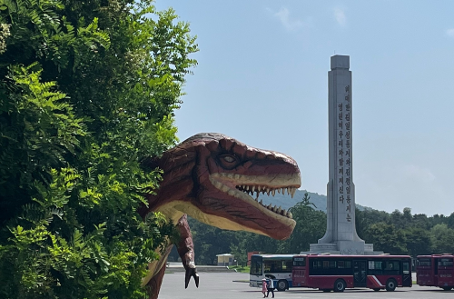
Then we were taken to the zoo. (Where are you now, liberal detractors would say). Here’s what I noted on the way – unfortunately, the world-famous control girls have disappeared from the streets of Pyongyang. They were one of the informal symbols of North Korea.
Many Korean girls, by the way, serve in the army. We always meet them at museums and memorials. They act as tour guides or security guards. They are taller than the average Korean woman, I’m not afraid to say, prettier. Their uniforms are not much different from men, except that instead of caps, they wear big Kim Il Sung caps with a star on them.
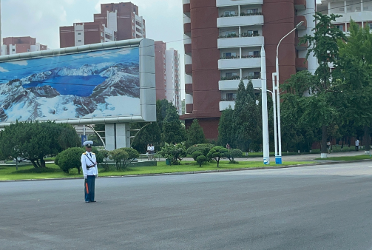
At the crossroads, the girls were replaced by policemen. In such heat, one feels sorry for them, as they stand under the scorching, merciless sun in full uniform. They are wearing dark turquoise trousers, a white shirt with a black saddle tie, a white square jacket with a tightening harness on top. A white bowl cap on his head. Especially those whose post is in the open sunny space are not enviable – many try to fit in the shadow of a nearby post.
The rules of the road are the same as the rest of the world, but I’ve noticed a few peculiarities. Firstly, if the road is multi-lane, there is a different speed limit for each lane, such as right-to-left 40/60/70. When overtaking someone, it’s customary to honk, and since there aren’t many cars, you don’t have to honk very often. Also due to the small number of cars, pedestrians crossing the road and drivers are in an equal position, no one has priority – whoever gives way, gives way.
Road life in Pyongyang: https://dzen.ru/video/watch/66f81d5904c8016ebdde2e95?share_to=link (Video)
Another rule is that there is a speed limit, when you drive past the Sun Palace, where the embalmed bodies of Kim Il Sung and Kim Jong Il are located. You must drive past the complex at a respectfully slow speed. Which we did once again on our way to the zoo.
But we did not get to the zoo itself, we were led to an entertainment centre, one entrance to which was decorated in the form of an open mouth of a tiger, and at the other there were a couple of cute dinosaurs.
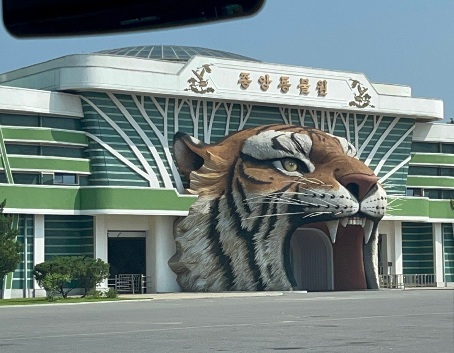
The entertainment center was a mixture of anthropological, zoological and astronomical museums – children receive a comprehensive education through entertainment.
I still accept astronomy, though I think that we don’t need to go into the depths of space, because who knows what infernal creatures we’ll make ourselves known to. But as an obscurantist and a person who believes in our Lord Jesus Christ, I think that dinosaurs are a fiction of scientists. In general, what impudence to assert on the basis of some found bone of incomprehensible origin, that there were several million years ago! Scientists have invented some monsters, drew their faces and tails, even made a classification, based in fact only on their ill-founded or poorly substantiated hypotheses. In general, on fantasies of scientists of past dinosaurs, it is possible to estimate the horrors going on in their minds. However, I digress.
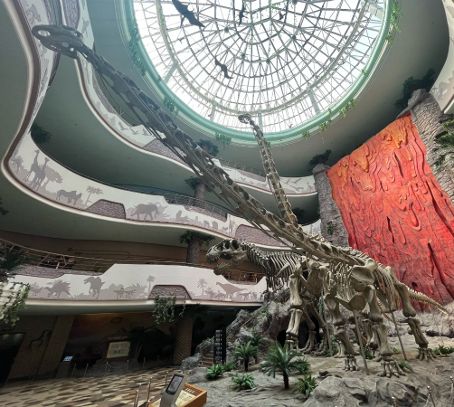
We were greeted by the skeletons of three dinosaurs, two of which had their heads stretched up to the dome itself. First, we were taken to the astronomical hall, then to the world of so-called dinosaurs, which moved their jaws and tails, growled and shouted. Then we went to a diorama where all the dinosaurs were hit by a meteor shower. It was very convenient for the scientists – they invented the monsters and killed them themselves.
Then there were animals, some beetles, lizards according to the scientists’ version crawled out on the ground. And of course, the caveman was not slow to appear. That’s what scientists think their ancestors looked like. For God’s sake, of course, think so, let it be your relatives, but why impose your sick fantasies on everyone else.
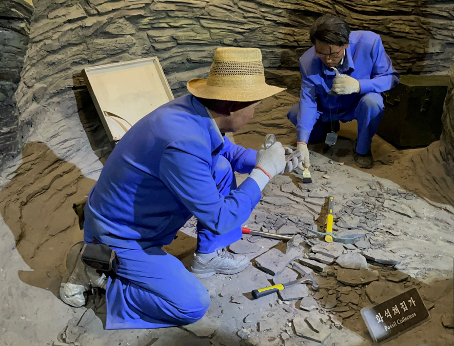
Koreans are good at wax statues; in one of the niches, the wax Korean researchers looked as if they were alive. Mostly, the halls embodied other people’s research, but there were certainly some Korean achievements, such as an ancient toothy bird creature, the remains of which were discovered on the Korean peninsula.
By the way: Global changes in the DPRK’s foreign policy, which have occurred recently, unnoticed by political scientists, can also be found in the entertainment centre.
In one of the zoological halls a map shows the migration of birds. On it, the territory of the DPRK from the south was limited to the 38th parallel, although earlier the North Koreans claimed the entire Korean peninsula and painted the whole territory as theirs. This global change took place in February this year. At the last congress, Kim Jong-un proposed rewriting the constitution, removing the provisions for a united but divided nation. He ordered to stop all talks on the unification of the two Koreas as futile. He demanded that South Korea be recognised as the first hostile state.
But behind the outward aggressiveness of this step, one can see, on the contrary, a plan to defuse the situation in the region. Thus, Kim Jong-un recognised the southern border along the 38th parallel, albeit with the reservation that in case of provoked war the North Koreans would occupy the territory of the entire peninsula. Now the DPRK may consider North Koreans and South Koreans to be two different peoples, but it has declared the renunciation of the uncontrolled territory. In general, in the future it is possible to demand that sanctions be lifted. Indeed, why, for what reason is the DPRK under global blockade?
The separation, by the way, is taking place. The language is changing, and in physiological terms the new generations of North Koreans are different: the gene pool was influenced by the difficulties of the Great Campaign and the consequences of famine.
The world map looks unusual to the Russian eye. In the centre there is a tiny, isolated DPRK and an unfolded blanket of the Pacific Ocean. By the way, there is no Yellow Sea on the map, much less the Sea of Japan. Only the East and West Seas wash the Korean Peninsula from two sides. They are symbolically reflected in the blue stripes of the national flag.
In one of the halls, our delegation laughingly found an effigy of Kherson’s Homunculus Loxodontus – a half-pig anteater.
In the entertaining zoo centre you can meet playing machines, which are also in Russia, for example metal tentacles pulling out toys.
We were not taken to the zoo with live animals, although initially it had been planned. Apparently, something happened that changed the plans or affected the saturation of the programme.
We were taken to the only Orthodox church in the DPRK. But personally, visiting the church in Pyongyang left an unpleasant impression on me. In spite of the presence of external and internal attributes of Orthodoxy, placed domes and crosses, iconostasis, donated different icons – it is an absolutely false institution, just like the Buddhist temple in the Myohyang mountains.
The only orthodox church in Korea (video): https://dzen.ru/video/watch/66f7cee3800c4546a3e0e4e3?share_to=link
When we arrived, they were already waiting for us and it was obvious that they were preparing for our arrival. A smooth-shaven Korean man in a cassock told us that the church was built in 2006 on the initiative of Kim Jong Il by Korean builders at the expense of the Korean government. The church was named Holy Trinity Church. A Korean priest and two deacons, who graduated from a theological seminary in Russia, serve there on Sundays and holidays, the Korean said. The priest in the cassock and cross was also smooth-shaven and questionable. The choir is sung by three able Korean women from the local philharmonic. Not Christian.
Yes, by building the church, they wanted to make Russians feel good. But I would like to tell Koreans that church is always a congregation and parishioners, it is not a room, not a building, it is a gathering of people. The church is always alive, and where we were brought, despite the icons presented and hung on the walls, it looked like an unnecessary museum at most.
– The total area of the church is 350 square metres, the height to the dome, to the cross – 30 metres, – provided the Korean irrelevant and unnecessary information for the church.
– And where is Father Fyodor? – asked my colleague who had been here before.
– Father Fyodor doesn’t work here anymore,’ replied the dressed-up Korean in a cassock.
What happened to Father Fyodor, we can only speculate. Maybe he was the real rector.
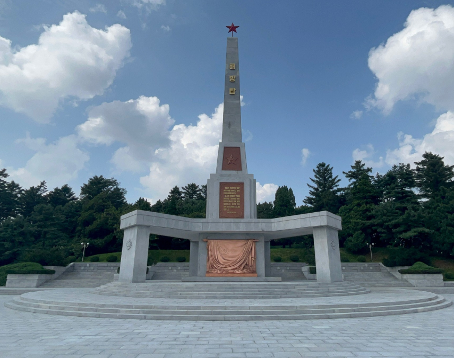
Then we were taken to the monument to Russian-Korean friendship. This is a real monument, a living one – a huge stele on a hill overlooking the whole of Pyongyang. The stele weighs 815 tonnes, the weight has a symbolic meaning – August 15, 1945 is the day of liberation of Korea by joint troops from the Japanese. The stele is made up of 509 stones – the date 9 May is embedded in the number. At the base of the stele there is a panel on which Russian and Korean soldiers are depicted, and a Russian soldier in a cap and with a moustache, which testify to the authenticity of the image.
In general, it is nice to see that, while all over Europe Soviet monuments are being destroyed, Koreans care about the memory of our heroic ancestors. It is immediately clear who is our friend and who is our enemy.
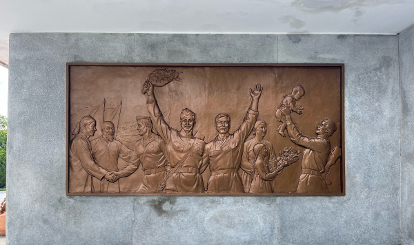
Our day’s schedule was very full and we went bowling. Yes, there is bowling in Pyongyang, and North Korea has fun. The contingent that comes here may not be easy – I judged by the foreign cars pulling up, the haughty Korean women wearing modest but gold jewellery, the beads around their necks, the shoes on their feet, the dresses, though not luxurious, but different from the everyday clothes I had seen Pyongyang women wearing on the street before.
The girls accompanied the boys, they came here with children, they played the machines.
Koreans gamble as Russians do. Also, with pleasure, they drink beer, and roll balls happy to strike. Everything happens like in Russian bowling alleys, except that you rarely see Koreans there. But Russians are not frequent guests in Pyongyang bowling alleys either.
Watch this video to see a bowling hall in Pyongyang: https://dzen.ru/video/watch/66f81f5430e4811b8916e3c1?share_to=link
We split into two teams, the first team won lead by me, although I was playing for the fifth time in my life, and the second team was led by our Korean driver. He had a face like a twisted dumpling, and he didn’t speak Russian, he taught me how to twist the balls with gestures, and he played very professionally, scoring the maximum number of points of the participants of the two groups. By the way, it is quite possible that he is the most important in the group of attendants. In North Korea, it can be like that. You communicate in a group with some people, and it turns out that the driver is the most important.
But that wasn’t all – today was dedicated to entertainment, and in the evening, we went to the amusement rides. Pyongyang has its own holiday park, of course, it is inferior to Gorky Park in Moscow and the ‘Divo-Island’ on Krestovsky in St. Petersburg. But all the standard entertainment is available. But from the park you can see the largest stadium in the world: the ‘First of May’ Stadium for 114 thousand spectators. Who said that DPRK is a backward country? You’re the ones who are backward.
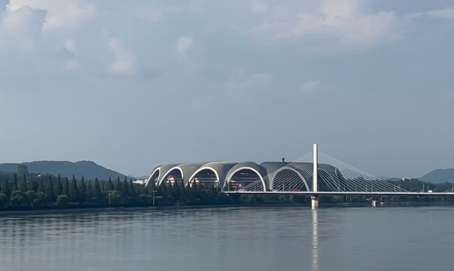
The rides included not American, but Russian roller coasters, electric cars and a merry-go-round. A steam train with a beech Z made a merry commotion in our ranks. There are beer gardens in the park. It is hot, and Korean men take off their jackets and shirts, to which the badges of the leaders are pinned and sit in white T-shirts. The children looked at us foreign tourists with interest. Noticing our gaze, they bowed fidgetily. It is their custom to show deference to adults.
Scenes from Pyongyang’s amusement park here: https://dzen.ru/video/watch/66f811a3ab9fe71959a66cf5?share_to=link (Video)
The number of cicadas in the park was off the charts, the trees seemed alive, and the crackling sound came in waves and even drowned out conversation. One can imagine how American soldiers felt when they were in a foreign Korean forest in the summer more than 70 years ago. For them, the crackling was ominous, and behind the crackling lurked their deaths.
Take a moment and listen to the truly incredibile sound of cicadas in the trees here in the following video: https://dzen.ru/video/watch/66f8187895b87a0c55870dca?share_to=link
As we were leaving the amusement park, we witnessed the first conflict situation during our stay here – one Korean man was fighting with another, shouting at him while his lady was dragging him away under her arm. The Korean woman was unfazed and silently pulled her heated beau away from the conflict. We watched the scene with curiosity. And suddenly, the girl also absolutely silently and nonchalantly slapped the guy’s cheeks with a fan to calm him down. And pulled him again.
Yes, people live here, too. And nothing human is alien to them.
To be continued…
This article was previously published in Russian here. Translation to English by UWI.

















Leave a Reply